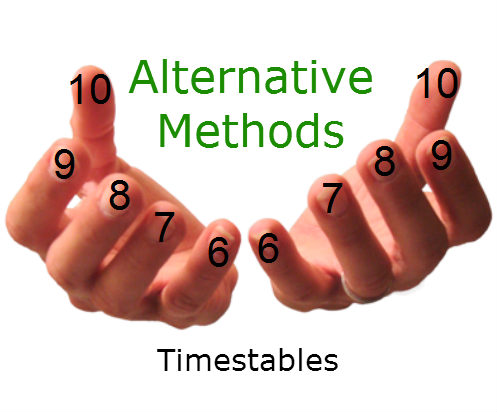 | Time: 1hr. Designed for students that by the age of 11 are still having significant difficulties with some or all of their timestables. Short (1min) videos show carefully selected, 'memory light' and generally, alternative methods, to those used in schools. The activity provides lots of support materials for students to self-test and for teachers to rapidly produce tailored, classroom resources. |
 | Time: 1hr. Mostly about the techniques we use to convert between fractions and decimals, but in the engaging context of a debate about which is easiest. Thinking critically about this question requires a thorough investigation in to both. Who will come out on top? |
 | Time: 1-2 hrs. This is an exploration/investigation into what makes a recurring decimal. It involves the conversion of fractions into recurring decimals and, at the end, back again, but principally invites students to think about the types of fractions that will produce terminating or recurring decimals. Lots of good thinking involved. |
 | Time: 1-2hrs. This is a playful activity that encourages students to manipulate surds in different ways so that they might spot the important relationships between them. This leads to simplifying and working with surds. A good activity followed by some thorough practice. |
 | Time: 30 mins to 1h+ This is a really simple looking exercise designed to help students be clear about the interplay between ratios and fractions that are describing the same proportions. The puzzles will also involve quite a lot of numerical and proportional reasoning as they get harder to solve! |
 | A favourite activity for fractions. This practical task is perfect for motivating students to consider fraction equivalence. The incentive is to eat as much chocolate as possible! There is also a great opportunity for students to use creativity to communicate their mathematics effectively. Time: 1 hour. |
 | Time: 1h+ This is a number puzzle that demands students play with the notion of equivalent ratios. Students are given 40 numbers to work with and asked a series of questions about equivalent ratios. The answers have to come from the given list of numbers. The activity culminates in a challenge to use all 40 numbers to solve one problem! |
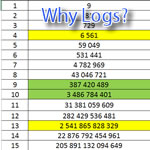 | Time: 1hr+ Is there a quicker way to solve 984 876 543 210 x 875 622 375 933 without a calculator? Students get experience of using log tables, try to graph data with a very wide spread and gain an understanding for the use of logs. Online quizzes put this knowledge to the test and iphone & android apps offer opportunities for further exploration using decibel & Richter scales. |
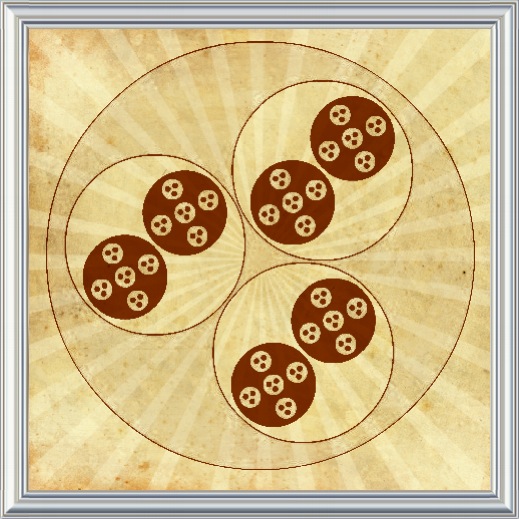 | Time: 1hr+ Students solve puzzles and unravel the mystery of numbers through prime number decomposition in this activity based around the idea of wonderful  Primitives manipulative. The activity includes different approaches, lots of rich discussion and culimates in students producing some great work for memory aids and classroom display. Primitives manipulative. The activity includes different approaches, lots of rich discussion and culimates in students producing some great work for memory aids and classroom display. |
 | Time: 1hr+ Each calendar year should start with this great puzzle that gets students to think critically and creatively to find as many different possible solutions for the numbers from 1 to 100 using only the digits 2,0,2 & 3. Anything goes: exponents, factorials and recurring decimals are allowed! Student grids, a classroom poster and manipulatives are provided for this ready to use activity. |
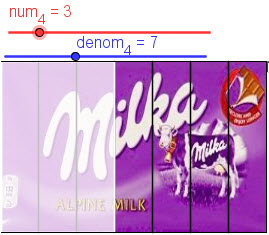 | Time: 30mins - 1h. Students play Snakes and Ladders where every square is a mixed number or improper fraction. They use the chocolate bar applet to help them visualise and understand conceptually how to convert from mixed numbers to improper fractions and vice versa. If they answer correctly (partner's can use calculator's to check) they roll the die and move, otherwise they miss a turn. |
 | Time: 1h. Students form interesting groups using their bodies to get a physical appreciation for factors and multiples. They then create a wide range of imaginative designs using counters, beads, collage etc. to represent numbers in terms of their factors for other groups to decipher. Finish with the multiple factors game. Be prepared for a lot of fun! |
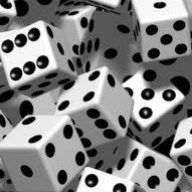 | Time: 30-45 mins. This is a simple and engaging game to help students practise rounding decimals to one or two decimal places and adding and subtracting with decimals. Playing in pairs, students take turns to generate numbers between zero and ten using dice. They round the numbers and keep a running total of the numbers they have made. The strategy is to get as close to 50 as possible after ten turns. Play online or on paper! |
 | Time: 1-2hrs A discovery based investigation to learn the rules for dividing fractions. It explores the idea that multiplication and division are not different and students use what they already know about multiplying fractions to figure out dividing for themselves (justifying their results by visualising the divisions with fraction diagrams). Students must be confident in their ability to multiply fractions before attempting this activity. |
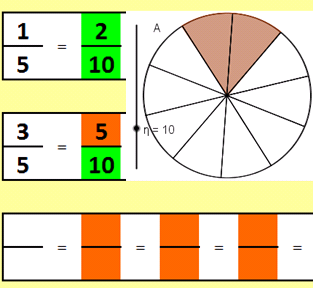 | Time: 1h. Students move a slider to visualise why some fractions are equivalent and others aren't. This task aims to make a link between the act of cutting up (sharing out) pieces of pizza and their numerical, fractional representation. Students self-check their answers in excel and have to simplify to "lowest terms". Green indicates they are right, orange, try again! Mixed numbers included. |
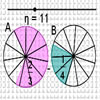 | Time: 1h. By moving the slider, students use the Geogebra applets to look for common denominators. Once they have found this common denominator, they must enter the equivalent fractions into an Excel spreadsheet, along with their answer, to check if they are right or not. Have they found the lowest common denominator? |
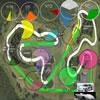 | Time: 30mins-1h. Students have to choose two fraction pieces of a circle to fill the eight holes of a race track to allow them to complete the race (same activity can be done on paper, with the track and pieces, laminated and cut out in class sets for future use), entering their estimation for the total of the two pieces combined in Excel. |
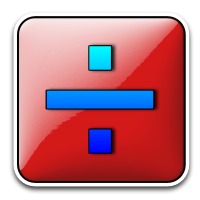 | Time: 1hr. This is a classic divisibility problem. Students are asked to solve it by creating a spreadsheet. As such this is good practice for programming spreadsheets with formulae, place value as well as divisibility. As a whole, the task is very good for developing problem solving skills. In short, arrange the digits from 1 to 9 such that the first digit is divisible by 1, the first 2 digits by 2 and so on. |
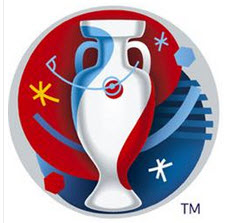 | This activity sheet offers a concrete example of how fractions, decimals, percentages and ratio are used to measure and define proportions and help us to make "good" decisions. See this blog post  Euro 2016: Fractions, Decimals, % Euro 2016: Fractions, Decimals, % |
 | Time: up to 1hr. Practise adding, subtracting, multiplying and dividing fractions in the context of some puzzles and challenges. The aims of this activity are both to provide a context for practice and to get students to think a few moves ahead. If done well, students think quite deeply about manipulating fractions. |
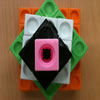 | Time: 1-2hrs. Students create visual representations of squares and cubes using multilink cubes, taking photos & creating a presentation on the concept of squaring, cubing and rooting. They explore the patterns to be found in the difference of two squares: experimenting, collecting data, conjecturing and testing (proving?) . . . |
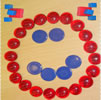 | This lesson requires students to produce a range of images for a given ratio. The aim is to draw out the equivalence of different ratios and how, and why, they can be simplified. The more creative and imaginative students are in creating different images to fit a given ratio, the clearer the true concept of ratio becomes (great opportunity for display work). It also provides a good lead in to sequences and graphs. Time: 1h+ |
 | This activity provides an interesting context to make some proportion and ratio calculations. Google Earth is used to make measurements about distance and angles of longitude and latitude. These are then combined to make calculations about the circumference of the Earth. No previous knowledge of Google Earth is required. Time: 1 to 1.5 hr |
 | Students do not, in their day-to-day lives, have much experience of very small numbers nor of very large numbers. Consequently, they cannot understand the complication with rounding to 1 decimal place, the nearest 1000, 3 decimal places etc. This activity takes them, visually, thanks to some free virtual reality sites, into the world of the very small, and the uninimaginably large! Time: 1-2 hrs |
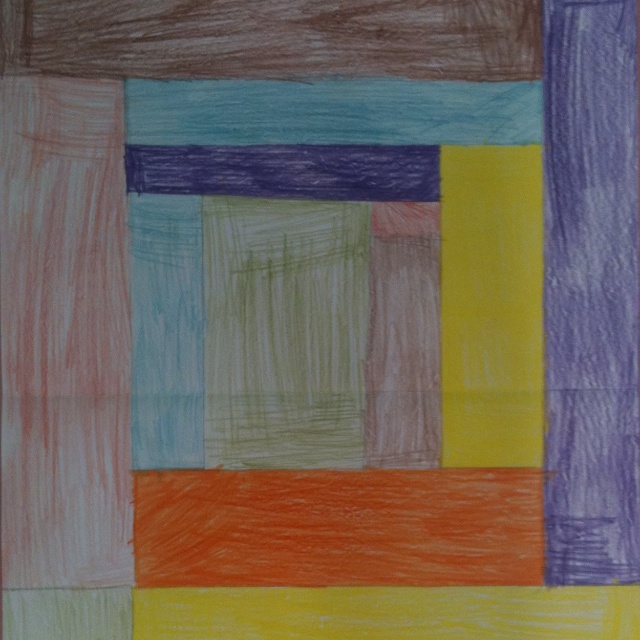 | Create some great art and display work whilst practising calculating fractions of different quantities. This activity involves the repeated splitting of rectangles into carefully chosen proportions defined by a single fraction and can lead to some lovely 'Mondrian inspired' pictures! Time: 1 hr |
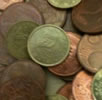 | Time: 1h Using coins, or working on paper, students decide which amounts can and can't be made exactly using 2 cent and 5 cent coins. The teacher supplies the coins to give students something concrete to focus on and it also adds to the excitement of winning coins from their partner! Students find the surprising result that almost all numbers are possible save 1 and 3. This leads to further investigation into multiples and factors using technology. |
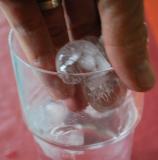 | Adding and subtracting negative numbers are so often misunderstood. These activities give a simple fool-proof way of getting it right. Resources include a simple step by step demonstration likening adding and subtracting negative numbers to adding coldness to a drink, games and a self checking spreadsheet. The series of games is fun and engaging. Time: 1-2 hrs |
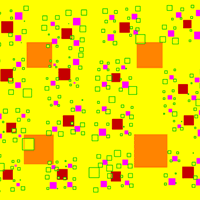 | 'Squared' and 'Cubed' can be explained by using 2 and 3 dimensions. The area of a square with length 5 is 52, volume explains cubed, so how can we represent 54? This activity explores visual representations of indices and draws on a little creativity! Time: 1 hr |
 | This activity is inspired by  'Of All The People in All the World' from 'Stan's Cafe'. Use grains of rice to represent different numbers of people! How can we make a pile of rice with 1,000,000 grains in it? Do the estimation then use some statistics to make a powerful display! Time: 1 - 3hrs 'Of All The People in All the World' from 'Stan's Cafe'. Use grains of rice to represent different numbers of people! How can we make a pile of rice with 1,000,000 grains in it? Do the estimation then use some statistics to make a powerful display! Time: 1 - 3hrs |
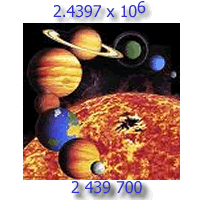 | In this investigation students work out for themselves how to convert an ordinary number to standard form and back again using Excel and/or calculators to explore the radius of planets and the distances separating them. An introduction to the world of the very big and the very small! Time: 1 to 3h |
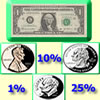 | This activity gets students to relate percentages to money. They'll need to be in pairs for a collection of two player games which will test how quickly they can work out a percentage. The aim is that they understand that percentages are simply the ability to divide by 10 or 100 and then use their timestables. Time: 1h |
 | This activity is designed for students to find out why PRIME numbers really are PRIME (what does "Prime" mean: "Prime Minister", "Prime time" TV etc.) and the DNA of the number system. They then use this DNA of numbers to solve a crime . . . Time: 1h |
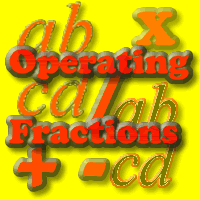 | Practising and generalising operations with fractions. Students are asked to substitute values into partial generalisations for equivalent, adding, multiplying and dividing fractions. They practise the skills in doing so. Students are then asked to search for the limiting conditions of the generalisations and express them as generally as possible. Time: 1 hr |
 | For many years the study of prime numbers was an abstract, mathematical pursuit. In the modern world there are an increasing number of applications. This activity explores an application in nature that is easily accessible (and engaging) to younger students and leads to a need for LCM and HCF. Time: 1 to 3 hrs |
 | Time: 1 to 1.5 hr This activity provides an interesting context to make some proportion and ratio calculations. Google Earth is used to make measurements about distance and angles of longitude and latitude. These are then combined to make calculations about the circumference of the Earth. No previous knowledge of Google Earth is required. |






























